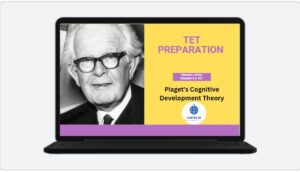Piaget’s Cognitive Development Theory In English
Piaget’s Cognitive Development Theory In English
The full meaning of the word TET is: Teacher’s Eligibility Test. According to the instructions of NCTE, currently, passing TET is one of the main conditions for employment in teaching from primary to higher secondary level. Keeping this in mind, we are presenting our efforts to help competing students in the TET Niryas section, where Study Materials on the content of West Bengal Primary and Upper Primary TET, CTET Paper-I and Paper-II and SLST are available. Incidentally, in the post called Piaget’s Cognitive Development Theory, various important information related to Piaget and his theory is discussed:

Piaget’s Cogitive Development Theory In English :
➲ Jean Piaget : Born: August 9, 1896, in Neuchâtel, Switzerland. Studied natural sciences and philosophy at the University of Neuchâtel and the University of Zurich. Earned his Ph.D. in malacology (the study of mollusks) at the age of 22. Died: September 16, 1980, in Geneva, Switzerland. Theory : Cognitive Development Theory.
➲ Early Life and Education : Jean Piaget was born on August 9, 1896, in Neuchâtel, Switzerland. He was the oldest child of Arthur Piaget, a professor of medieval literature, and Rebecca Jackson. Piaget’s early life was marked by a love of nature and a curiosity about the world around him.
Piaget began his education at the University of Neuchâtel, where he studied natural sciences and philosophy. He later transferred to the University of Zurich, where he earned his Ph.D. in malacology (the study of mollusks) at the age of 22.
➲ Career and Theory : Piaget’s career as a psychologist began in the 1920s, when he worked at the Alfred Binet Laboratory in Paris. During this time, he developed his theory of cognitive development, which posits that children progress through a series of stages, each characterized by a unique way of thinking and understanding the world.
Piaget’s Cognitive Development Theory Piaget’s theory of cognitive development is based on the idea that children actively construct their own knowledge and understanding of the world through hands-on experiences and social interactions. He believed that children progress through four stages of cognitive development: sensorimotor, preoperational, concrete operational, and formal operational.
➲ Key Concepts of Piaget’s Cognitive Development Theory : Some key concepts in Piaget’s theory include ⬎
1. Schemas: Piaget introduced the concept of schemas, which are mental frameworks that help individuals organize and make sense of their experiences. Schemas are like mental templates that help us understand and categorize information.
2. Assimilation: Assimilation is the process by which individuals incorporate new information into their existing schemas. When we encounter new information, we try to fit it into our existing schemas.
3. Accommodation: Accommodation is the process by which individuals adjust their existing schemas to fit new information. When we encounter new information that doesn’t fit into our existing schemas, we may need to adjust our schemas to accommodate the new information.
4. Equilibration: Equilibration is the process by which individuals balance assimilation and accommodation to achieve a state of cognitive equilibrium. When we encounter new information, we try to balance our existing schemas with the new information to achieve a state of cognitive equilibrium.
প্রাথমিক টেট প্রস্তুতির জন্য ক্লিক করুনঃ
উচ্চ প্রাথমিক টেট প্রস্তুতির জন্য ক্লিক করুনঃ
➲ Stages of Cognitive Development :
1. Sensorimotor Stage (0-2 years): Infants and young children learn by using their senses and motor skills to interact with the environment. During this stage, children learn to coordinate their senses and motor skills to achieve a sense of control over their environment.
◈ Characteristics of this Stage : ⦿ Learning through senses and motor skills; ⦿ Lack of symbolic thinking; ⦿ Egocentric thinking.
2. Preoperational Stage (2-7 years): Children begin to use symbols and language to represent the world, but their thinking is still egocentric and intuitive. During this stage, children begin to use language to communicate with others, but they still have difficulty taking other people’s perspectives.
◈ Characteristics of this Stage : ⦿ Use of symbols and language; ⦿ Egocentric thinking; ⦿ Intuitive thinking.
3. Concrete Operational Stage (7-11 years): Children develop the ability to think logically and solve problems using concrete objects and events. During this stage, children begin to use logic and reasoning to solve problems, but they still have difficulty with abstract thinking.
◈ Characteristics of this Stage : ⦿ Use of logic and reasoning; ⦿ Ability to solve problems using concrete objects and events; ⦿ Difficulty with abstract thinking.
4. Formal Operational Stage (11-15 years): Adolescents develop the ability to think abstractly and reason logically about abstract concepts. During this stage, adolescents begin to think about abstract concepts and develop their own theories and ideas.
◈ Characteristics of this Stage : ⦿ Ability to think abstractly; ⦿ Ability to reason logically about abstract concepts; ⦿ Development of own theories and ideas.
➲ Piaget’s Cognitive Development Theory & Implications for Education :
✧ Child-centered learning : Piaget’s theory emphasizes the importance of child-centered learning, where children are encouraged to explore and learn at their own pace.
✧ Hands-on learning : Piaget’s theory emphasizes the importance of hands-on learning, where children are encouraged to learn through direct experience and experimentation.
✧ Adaptation to individual differences : Piaget’s theory emphasizes the importance of adapting instruction to individual differences in cognitive development.
➲ Influence and Legacy : Piaget’s theory of cognitive development has had a significant influence on education and child development. His ideas about child-centered learning, hands-on education, and the importance of social interactions have shaped educational practices around the world.
➲ Criticisms and Limitations of Piaget’s Cognitive Development Theory : While Piaget’s theory has been influential, it has also been subject to criticisms and limitations. Some of the criticisms include:
✦ Too broad : Piaget’s stages are too broad and do not capture the nuances of individual development.
✦ Too rigid : Piaget’s stages are too rigid and do not allow for individual differences in development.
✦ Lack of empirical support : Some of Piaget’s theories have not been supported by empirical research.
➲ Later Life and Death : Piaget continued to work and write until his death on September 16, 1980, at the age of 84. He died in Geneva, Switzerland, leaving behind a legacy of groundbreaking research and theory in the field of cognitive development.
➲ Important books and papers of Jean Piaget:
➱ Books:
✦ The Language and Thought of the Child (1923) : This book is a comprehensive study of the language and thought of children, and it lays the foundation for Piaget’s theory of cognitive development.
✦ The Child’s Conception of the World (1926) : In this book, Piaget explores the child’s understanding of the world, including their concepts of space, time, and causality.
✦ The Origins of Intelligence in Children (1936) : This book is a comprehensive study of the development of intelligence in children, and it lays the foundation for Piaget’s theory of cognitive development.
✦ Play, Dreams, and Imitation in Childhood (1945) : In this book, Piaget explores the role of play, dreams, and imitation in the development of children’s cognitive abilities.
✦ The Construction of Reality in the Child (1937) : This book is a comprehensive study of the child’s construction of reality, including their understanding of objects, space, and time.
➱ Papers:
☆ “The Language and Thought of the Child” (1923) : This paper is a summary of Piaget’s book of the same name, and it lays the foundation for his theory of cognitive development.
☆ “The Child’s Conception of Causality” (1927) : In this paper, Piaget explores the child’s understanding of causality, including their concepts of cause and effect.
☆ “The Stages of Intellectual Development” (1954) : This paper is a comprehensive overview of Piaget’s theory of cognitive development, including the four stages of sensorimotor, preoperational, concrete operational, and formal operational.
☆ “The Role of the Environment in the Development of Intelligence” (1955) : In this paper, Piaget explores the role of the environment in the development of intelligence, including the impact of social and cultural factors.
☆ “The Psychology of Intelligence” (1950) : This paper is a comprehensive overview of Piaget’s theory of intelligence, including his concepts of sensorimotor, preoperational, concrete operational, and formal operational intelligence.➮ বাংলায় পড়ুন

